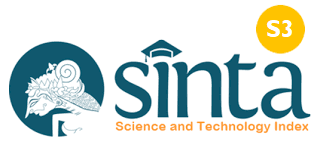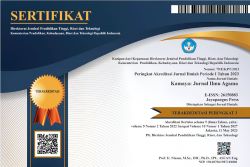Tinjauan Praktis Tentang Resolusi Konflik Berdasarkan Filemon 1:1-25
DOI:
https://doi.org/10.37329/kamaya.v5i3.1903Keywords:
Conflict Resolution, Brotherhood, God's OwnershipAbstract
In general, researchers only focus on taking a practical approach to Paul trying to reconcile Philemon with Onesimus. Onesimus is a slave who has run away from his master, Philemon. Conflict resolution in Paul's letter to Philemon has not yet been researched. The purpose of this research is to find conflict resolution based on Philemon 1:1-25. The method used in this research is qualitative with a literature study approach. The result of the research on conflict resolution in Philemon 1:1-25 is that reconciliation must be realized based on the ties of brotherhood obtained from God's Ownership.
References
Baxter, J. S. (1960). Explore the Book, (6 vols). Grand Rapids: Zondervan.
Belo, Y. (2020). Implementasi Komunikasi Paulus Dalam Menyelesaikan Masalah Berdasarkan Surat Filemon. Phronesis: Jurnal Teologi Dan Misi, 3(2), 147–157.
Bobgan, M., & Bobgan, D. (1985). How to counsel from Scripture. Chicago: Moody Press.
Bratcher, R. G., & Nida, E. A. (2019). Surat-surat Paulus kepada jemaat di Kolose dan kepada Filemon. Bogor: Lembaga Alkitab Indonesia.
Carson, H. M. (1970). The Epistles of Paul to the Colossians and Philemon: an introduction and commentary. Chicago: Tyndale Press.
Chia, P. S., & Juanda, J. (2020). Penafsiran Amilenialisme & Teologi Kovenan Dalam Memahami Alkitab. Journal KERUSSO, 5(2), 1–23.
Crabb, L., & Crabb, L. J. (1975). Basic principles of biblical counseling. New York: Harper Collins.
Goble, F. G. (1987). Mazhab ketiga, psikologi humanistik Abraham Maslow. Jakarta: Kanisius.
Joseph, L. S. (2018). Perdamaian Sebagai Proses Resolusi Konflik Keluarga Kristen. Institutio : Jurnal Pendidikan Agama Kristen, 4(1).
Lase, H. J., Subambang, B., Santosa, B., & Sirait, S. (2021). Pengaruh Minat Baca Alkitab Terhadap Pertumbuhan Kerohanian Mahasiswa. Skenoo : Jurnal Teologi Dan Pendidikan Agama Kristen, 1(1), 37–44.
Marney, C. (1964). The Miracle of Dialogue. New York: JSTOR.
Pranoto, D. S. (2018). Model Kepemimpinan Paulus: Sebuah Studi Eksposisi Surat Filemon. Manna Rafflesia, 5(1), 37–49.
Riyadi, E. (2016). Pengantar ke dalam Kitab Suci. Yogyakarta : Kanisius.
Santoso, A. (2011). Hiburkanlah Buah Hatiku: Tafsir Surat Filemon. Bandung: BMI.
Scheunemann, R. (2011). Surat Paulus Kepada Filemon. Jakarta: BPK Gunung Mulia.
Sirait, J. R. (2021). Kajian Teologis tentang Metode Penyelesaian Masalah Pribadi Berdasarkan Surat Filemon 1:4-22. 1–39.
Sirait, J. R., & Istinatun, H. N. (2022). Akseptasi Teologi Pada Kerukunan Umat Islam dan Kristen di Indonesia. Kamaya: Jurnal Ilmu Agama, 5(2), 79–86.
Stuhlmacher, P. (1989). Der Brief an Philemon (Vol. 18). Switzerland: Benziger.
Sugiharto, A., & Sirait, J. R. (2022). Women’s Witnesses in the Resurrection of Jesus and Implications in Church Service. Jurnal Teologi (JUTEOLOG), 2(2), 221–234.
Tan, C., Ming, D., & Sirait, J. R. (2022). Kajian Makna Ibadah Pada Masa Pandemi Covid 19. Aletheia: Jurnal Teologi Dan Pendidikan Kristen, 3(1), 39–49.
Utley, B. (1998). Paul bound, the gospel unbound: letters from prison (Colossians, Ephesians and Philemon, then later, Philippians). Texas: Bible Lessons International.
W. R. F. Browning. (2007). Kamus Alkitab. Jakarta: Gunung Mulia.
Wijaya, H. (2020). Analisis Data Kualitatif Teori Konsep Dalam Penelitian Pendidikan. Makassar: Sekolah Tinggi Theologia Jaffray.
Windarwati, M. T., Sirait, J. R., Istinatun, H. N., Parulian, T., & Emeliana, E. (2021). Relevansi Transformational Leadership Di Lembaga Pendidikan Kristen. Jurnal Pendidikan Agama Kristen (JUPAK), 2(1), 1–12.
Wright, H. N. (2004). The Marriage Checkup (1st ed.). Jakarta: Immanuel.
Downloads
Published
How to Cite
Issue
Section
License
Copyright (c) 2022 Kamaya: Jurnal Ilmu Agama

This work is licensed under a Creative Commons Attribution-ShareAlike 4.0 International License.
An author who publishes in the Kamaya : Jurnal Ilmu Agama agrees to the following terms:
- Author retains the copyright and grants the journal the right of first publication of the work simultaneously licensed under the Creative Commons Attribution-ShareAlike 4.0 License that allows others to share the work with an acknowledgement of the work's authorship and initial publication in this journal
- Author is able to enter into separate, additional contractual arrangements for the non-exclusive distribution of the journal's published version of the work (e.g., post it to an institutional repository or publish it in a book) with the acknowledgement of its initial publication in this journal.
- Author is permitted and encouraged to post his/her work online (e.g., in institutional repositories or on their website) prior to and during the submission process, as it can lead to productive exchanges, as well as earlier and greater citation of the published work (See The Effect of Open Access).
Read more about the Creative Commons Attribution-ShareAlike 4.0 Licence here: https://creativecommons.org/licenses/by-sa/4.0/.





